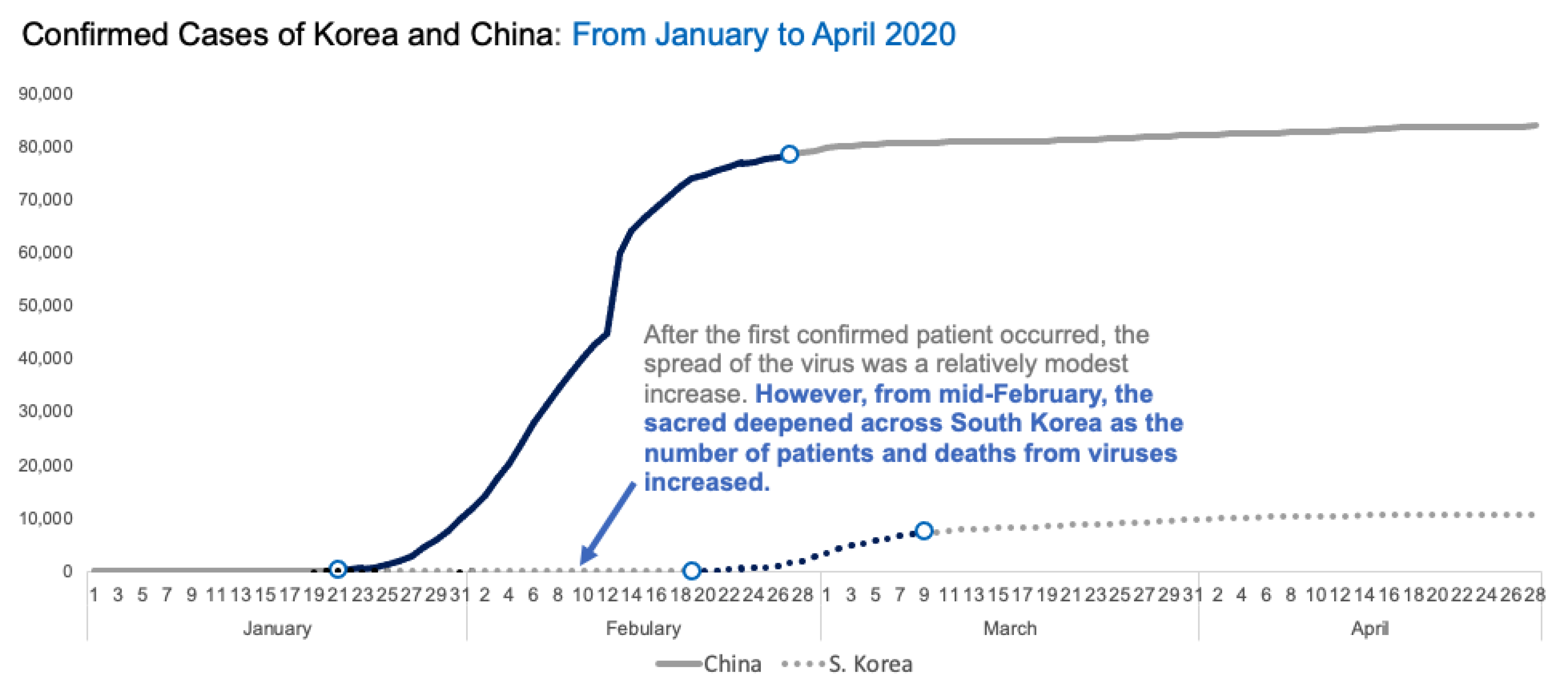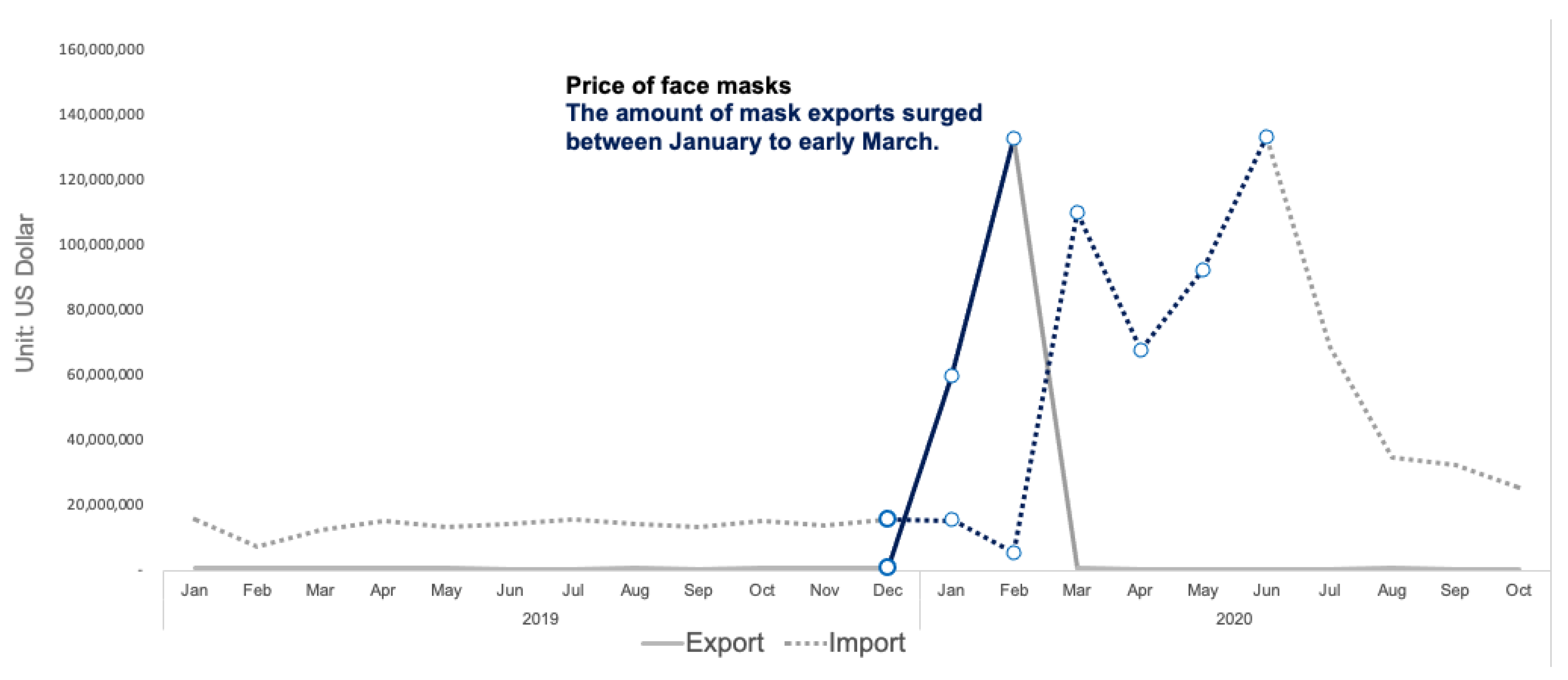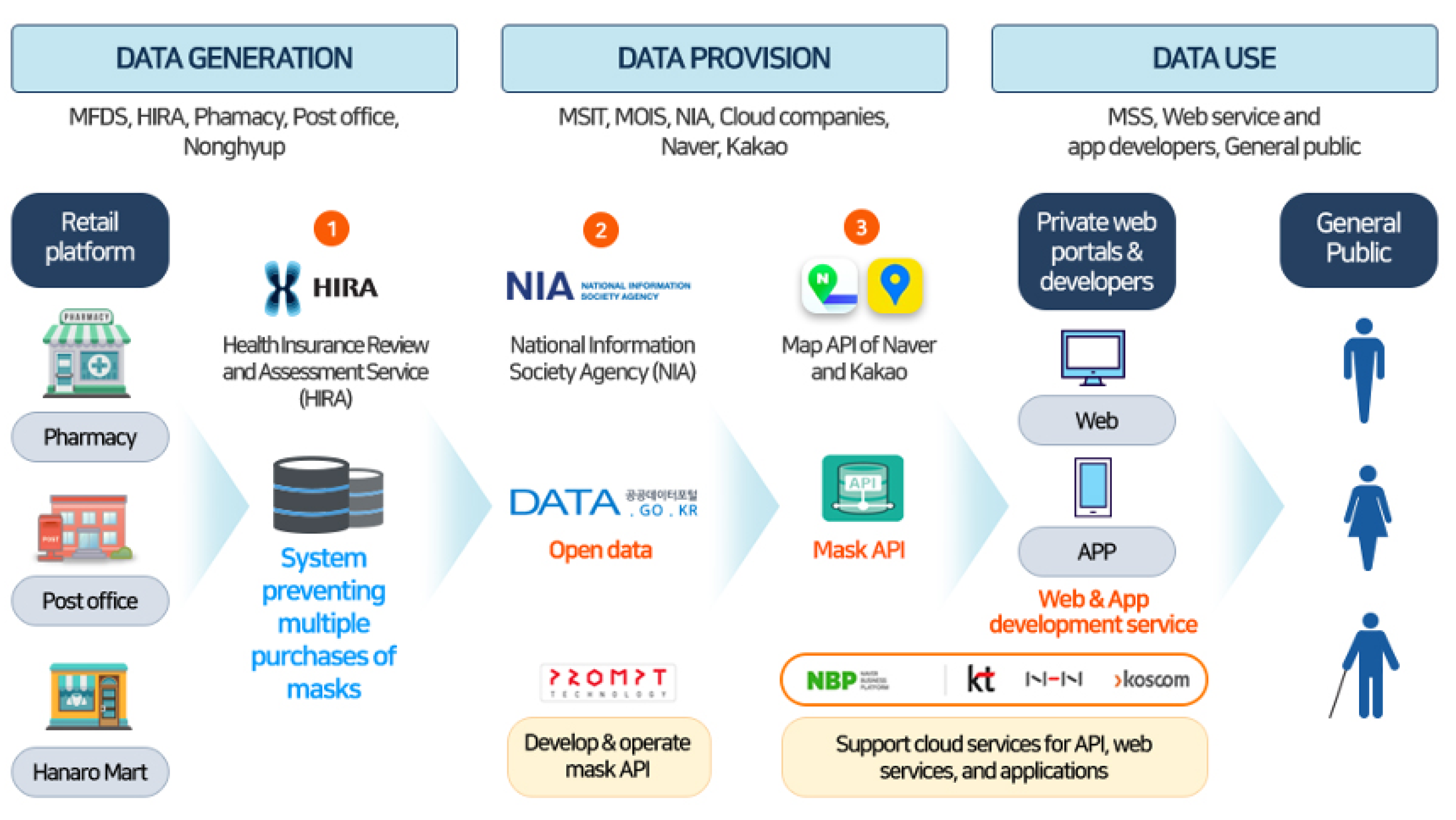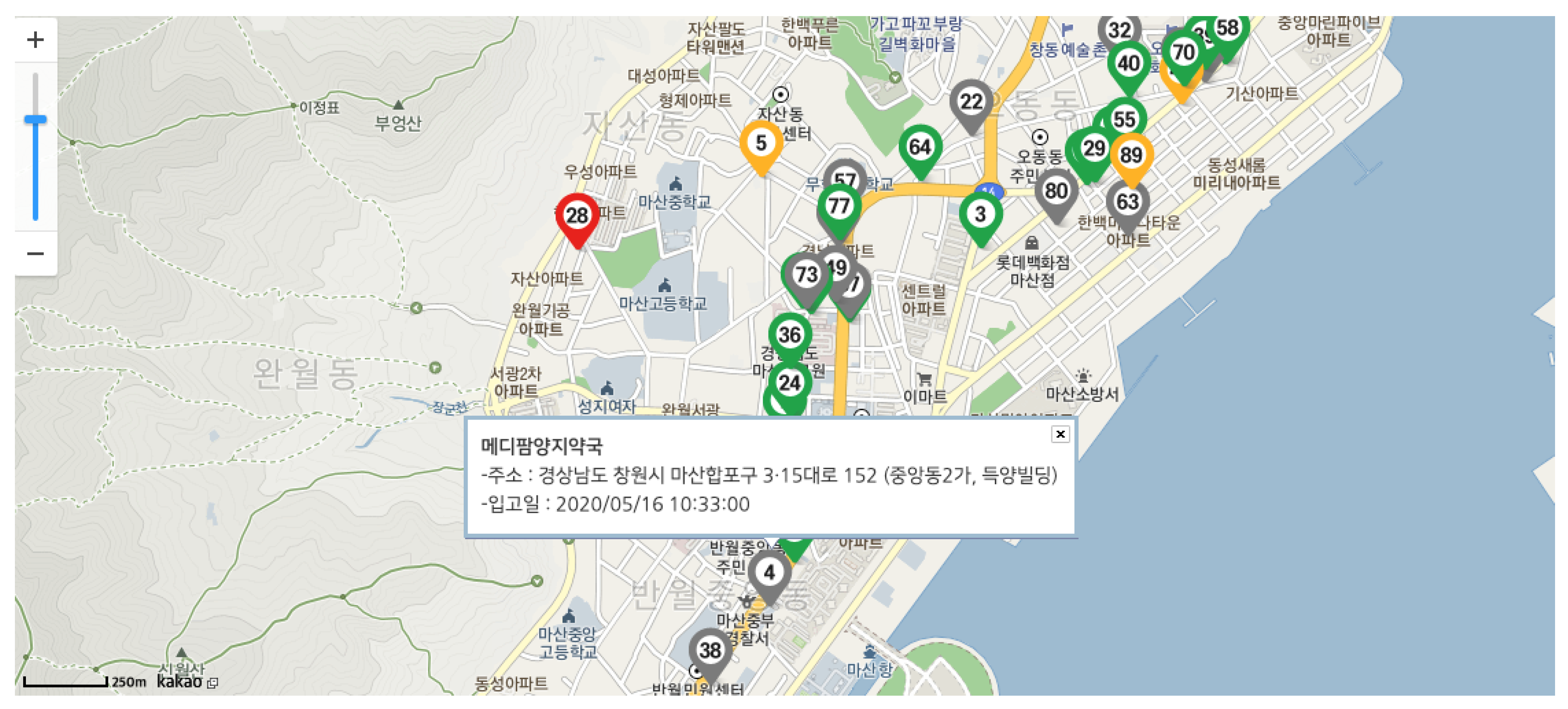Lesson Learned from the Power of Open Data: Resolving the Mask Shortage Problem Caused by COVID-19 in South Korea
Abstract
1. Introduction
2. Related Works
3. Response to COVID-19 in Korea
3.1. Confusing Guidelines for Mask Use
3.2. Imbalance between Supply and Demand
3.3. Face Mask Distribution System in Public
4. The Impact of Open Data
4.1. Background
4.2. Public Distribution of Face Mask Information Service
- Principle 1: the government and public institutions cannot solve everything.
- Principle 2: all issues and problems that may occur should be reviewed to provide a seamless service.
- Principle 3: all occurring issues or problems should be immediately shared and solved with all stakeholders.
4.3. Service Operations
- A method for updating sale stocks: because the new distribution system was implemented in a short time, individual pharmacies were required to understand the policies and adapt effectively on site. For example, pharmacies managed by one person or by senior employees cannot quickly update their mask stocks on the system, whereas other pharmacies distribute numeric tags and set individual start times for the mask sale. In addition, products initially packaged in units of 5 or 10 must be repackaged in sets of 2 at the pharmacy. Therefore, pharmacies require a function to allow for the update of sale times and inventory information, depending on the situation. As a result, the ‘Stop Selling’ button was implemented to reflect the stock of the pharmacy.
- Location information errors: the daily pharmacy information was received from HIRA in an Excel file. The NIA converted the addresses of individual pharmacies into geographical coordinates with mask stock information. However, the coordinates were not always placed according to the accurate location of a pharmacy on the map because the address was not up-to-date or in the incorrect format. Naver solved a set of coordinate errors by extracting the correct coordinate information based on the unique numbers of pharmacies (such as a nursing care symbol or business registration number). Over 2000 coordinates of more than 160 address errors were corrected, and duplicate addresses were removed.
- Agile API specification: the service operation for large-scale users presents many technical problems. For example, the provision of data can change according to subtle changes in the requirements and policies of the site. The API specification reflected changes three times, and the developer could easily investigate and apply it to the service by notifying the developer network of the disclosure and utilization of mask data.
5. Lessons Learned
5.1. Results
5.2. Discussion
6. Conclusions
Funding
Institutional Review Board Statement
Informed Consent Statement
Data Availability Statement
Conflicts of Interest
References
- Mckibbin, W.; Fernando, R. The global macroeconomic impacts of COVID-19: Seven scenarios. CAMA Work. Pap. 2020, 10, 116–156. [Google Scholar] [CrossRef]
- WHO. WHO Announces COVID-19 Outbreak a Pandemic; World Health Organization: Geneva, Switzerland, 2020; Available online: http://www.euro.who.int/en/health-topics/health-emergencies/coronavirus-covid-19/news/news/2020/3/who-announces-covid-19-outbreak-a-pandemic (accessed on 24 December 2020).
- Sohrabi, C.; Alsafi, Z.; O’Neill, N.; Khan, M.; Kerwan, A.; Al-Jabir, A.; Iosifidis, C.; Agha, R. World Health Organization declares global emergency: A review of the 2019 novel coronavirus (COVID-19). Int. J. Surg. 2020, 76, 71–76. [Google Scholar] [CrossRef] [PubMed]
- ECDC. COVID-19 Situation Update Worldwide, as of 29 May 2020; ECDC: Solna, Sweden, 2020. Available online: https://www.ecdc.europa.eu/en/geographical-distribution-2019-ncov-cases (accessed on 24 December 2020).
- Fernandes, N. Economic effects of coronavirus outbreak (COVID-19) on the world economy. SSRN Electron. J. 2020, 1–33. [Google Scholar] [CrossRef]
- Nicola, M.; Alsafi, Z.; Sohrabi, C.; Kerwan, A.; Al-Jabir, A.; Iosifidis, C.; Agha, M.; Agha, R. The socio-economic implications of the coronavirus pandemic (COVID-19): A review. Int. J. Surg. 2020, 78, 185–193. [Google Scholar] [CrossRef] [PubMed]
- Le, T.; Andreadakis, Z.; Kumar, A.; Román, R.; Tollefsen, S.; Saville, M.; Mayhew, S. The COVID-19 vaccine development landscape. Nat. Rev. Drug Discov. 2020, 19, 305–306. [Google Scholar] [CrossRef] [PubMed]
- Guadagno, L. Migrants and the COVID-19 Pandemic: An Initial Analysis; International Organization for Migration: Grand Saconai, Switzerland, 2020. [Google Scholar]
- Council, E. COVID-19 Coronavirus Outbreak and the EU’s Response. 2020. Available online: https://www.consilium.europa.eu/en/policies/covid-19-coronavirus-outbreak-and-the-eu-s-response/ (accessed on 24 December 2020).
- Hale, T.; Angrist, N.; Kira, B.; Petherick, A.; Phillips, T.; Webster, S. Variation in Government Response to COVID-19; Technical Report 6; Blavatnik School of Government: Oxford, UK, 2020. [Google Scholar]
- Feng, S.; Shen, C.; Xia, N.; Song, W.; Fan, M.; Cowling, B. Rational use of face masks in the COVID-19 pandemic. Lancet Respir. Med. 2020, 8, 434–436. [Google Scholar] [CrossRef]
- MOHW. Public Advice & Notice; Ministry of Health and Welfare: Sejong, Korea, 2020. Available online: http://ncov.mohw.go.kr/en/infoBoardList.do?brdId=14&brdGubun=141&dataGubun=&ncvContSeq=&contSeq=&board_id=&gubun= (accessed on 24 December 2020).
- Long, Y.; Hu, T.; Liu, L.; Chen, R.; Guo, Q.; Yang, L.; Cheng, Y.; Huang, J.; Du, L. Effectiveness of N95 respirators versus surgical masks against influenza: A systematic review and meta-analysis. J. Evid. Based Med. 2020, 13, 93–101. [Google Scholar] [CrossRef] [PubMed]
- Yonhap. Supply Shortage of Face Masks in S. Korea due to Chinese Buying Binge; Yonhap: Seoul, Korea, 2020; Available online: http://www.koreaherald.com/view.php?ud=20200203000556 (accessed on 24 December 2020).
- Lee, H.S. Face Mask Shortage Spreads to Korea, Too. 2020. Available online: http://www.koreabiomed.com/news/articleView.html?idxno=7331 (accessed on 24 December 2020).
- The Government of the Republic of Korea. How Korea Responded to a Pandemic Using ICT: Flattening the Curve on COVID-19; Technical Report; The Government of the Republic of Korea: Seoul, Korea, 2020.
- WHO. Novel Coronavirus(2019-nCoV) Situation Report-11; Technical Report; World Health Organization: Geneva, Switzerland, 2020; Available online: https://www.who.int/docs/default-source/coronaviruse/situation-reports/20200131-sitrep-11-ncov.pdf?sfvrsn=de7c0f7_4 (accessed on 24 December 2020).
- WHO. Water, Sanitation, Hygiene, and Waste Management for the COVID-19 Virus: Interim Guidance; Technical Report; World Health Organization: Geneva, Switzerland, 2020; Available online: https://apps.who.int/iris/rest/bitstreams/1275547/retrieve (accessed on 24 December 2020).
- Cook, T. Personal protective equipment during the COVID-19 pandemic—A narrative review. Anaesthesia 2020, 75, 920–927. [Google Scholar] [CrossRef] [PubMed]
- Society, R. Face Masks for the General Public; Technical Report; Royal Society DELVE Initiative: London, UK, 2020; Available online: https://rs-delve.github.io/reports/2020/05/04/face-masks-for-the-general-public.html (accessed on 24 December 2020).
- WHO. Advice on the Use of Masks in the Context of COVID-19; World Health Organization: Geneva, Switzerland, 2020; Available online: https://www.who.int/publications/i/item/advice-on-the-use-of-masks-in-the-community-during-home-care-and-in-healthcare-settings-in-the-context-of-the-novel-coronavirus-(2019-ncov)-outbreak (accessed on 24 December 2020).
- Howard, J.; Huang, A.; Li, Z.; Tufekci, Z.; Ždímal, V.; Westhuizen, H.M.; Delft, A.; Price, A.; Fridman, L.; Tang, L.H.; et al. Face masks against COVID-19: An evidence review. Preprints 2020, 2020040203. [Google Scholar] [CrossRef]
- Eikenberry, S.E.; Mancuso, M.; Iboi, E.; Phan, T.; Eikenberry, K.; Kuang, Y.; Kostelich, E.; Gumel, A.B. To mask or not to mask: Modeling the potential for face mask use by the general public to curtail the COVID-19 pandemic. Infect. Dis. Model. 2020, 5, 293–308. [Google Scholar] [PubMed]
- Chan, T. Universal masking for COVID-19: Evidence, ethics and recommendations. BMJ Glob. Health 2020, 5, e002819. [Google Scholar] [CrossRef] [PubMed]
- Cheng, V.; Wong, S.C.; Chuang, V.; So, S.; Chen, J.; Sridhar, S.; To, K.; Chan, J.; Hung, I.; Ho, P.L.; et al. The role of community-wide wearing of face mask for control of coronavirus disease 2019 (COVID-19) epidemic due to SARS-CoV-2. J. Infect. 2020, 81, 107–114. [Google Scholar] [CrossRef] [PubMed]
- Stutt, R.; Retkute, R.; Bradley, M.; Gilligan, C.; Colvin, J. A modelling framework to assess the likely effectiveness of facemasks in combination with ‘lock-down’ in managing the COVID-19 pandemic. Proc. R. Soc. A Math. Phys. Eng. Sci. 2020, 476, 20200376. [Google Scholar] [CrossRef] [PubMed]
- Mi-Na, K. What type of face mask is appropriate for everyone-mask-wearing policy amidst COVID-19 pandemic? J. Korean Med. Sci. 2020, 35, e186. [Google Scholar] [CrossRef]
- Lee, E.; Chen, Y.Y.; McDonald, M.; O’Neill, E. Dynamic response systems of healthcare mask production to COVID-19: A case study of Korea. Systems 2020, 8, 18. [Google Scholar] [CrossRef]
- NIFDSE. Guidelines for Standards of Health Masks (In Korean); Technical Report; National Institute of Food and Drug Safety Evaluation: Cheongju, Korea, 2019; Available online: https://www.nifds.go.kr/brd/m_15/down.do?brd_id=167&seq=12791&data_tp=A&file_seq=1 (accessed on 24 December 2020).
- Ham, S.H.; Won-Jun, C.; Wan-Hyung, L.; Seong-Kyu, K. Characteristics of health masks certified by the Ministry of Food and Drug Safety. Korean Soc. Environ. Health 2019, 45, 134–141. [Google Scholar]
- Ahn, S.H. Mask Sales Surged due to Concerns About Pneumonia in Wuhan. Out of Stock (in Korean). 2020. Available online: https://biz.chosun.com/site/data/html_dir/2020/01/28/2020012802731.html (accessed on 24 December 2020).
- MOHW. IMS Meeting for Novel Coronavirus Presided Over by the Prime Minister; Technical Report; Ministry of Health and Welfare: Sejong, Korea, 2020. Available online: http://www.mohw.go.kr/eng/nw/nw0101vw.jsp?PAR_MENU_ID=1007&MENU_ID=100701&page=3&CONT_SEQ=352865 (accessed on 24 December 2020).
- Korea, H. Korean Government Announced that No Need to Postpone or Cancel the Mass Event Such as KPOP Concert. 2020. Available online: https://www.habkorea.net/korean-government-announced-that-no-need-to-postpone-or-cancel-the-mass-event-such-as-kpop-concert/ (accessed on 24 December 2020).
- Choe, S. South Korean Leader Said Coronavirus Would ‘Disappear.’ It Was a Costly Error. 2020. Available online: https://www.nytimes.com/2020/02/27/world/asia/coronavirus-south-korea.html (accessed on 24 December 2020).
- KMA. Medical Consultation Conducts Survey on Corona 19 (In Korean); KMA: Seoul, Korea, 2020; Available online: http://www.mdon.co.kr/news/article.html?no=26450 (accessed on 24 December 2020).
- MOPSS. Enforcement Decree of the Framework Act on the Management of Disasters and Safety. 2018. Available online: http://elaw.klri.re.kr/eng_service/lawView.do?hseq=46616&lang=ENG (accessed on 24 December 2020).
- MFDS. Announcement: Eui-Kyung Lee, Minister of Food and Drug Safety, Urgent Inspection of Mask Production Site (In Korean). 2020. Available online: https://tinyurl.com/ya938s5y (accessed on 24 December 2020).
- CDCH. Announcement: Domestic Occurrence of New Coronavirus Infections (in Korean); CDCH: Hongkong, China, 2020; Available online: http://www.mohw.go.kr/react/al/sal0301vw.jsp?PAR_MENU_ID=04&MENU_ID=0403&page=1&CONT_SEQ=352708 (accessed on 24 December 2020).
- MFDS; KMA. Announcement: Recommendations for the Use of Masks to Prevent COVID-19. 2020. Available online: http://ncov.mohw.go.kr/shBoardView.do?brdId=2&brdGubun=21&ncvContSeq=239 (accessed on 24 December 2020).
- CDCH. Announcement: Revised Recommendations for Mask Use (Temporary Guidelines in Emergencies); CDCH: Hongkong, China, 2020; Available online: https://www.mfds.go.kr/brd/m_99/view.do?seq=43991&srchFr=&srchTo=&srchWord=&srchTp=&itm_seq_1=0&itm_seq_2=0&multi_itm_seq=0&company_cd=&company_nm=&page=1 (accessed on 24 December 2020).
- MOHW. THE 2015 MERS Outbreak in the Republic of Korea: Learning from MERS; Technical Report; Ministry of Health and Welfare: Sejong, Korea, 2016. Available online: http://nih.go.kr/board/board.es?mid=a20504000000&bid=0014&tag=&act=view&list_no=128379 (accessed on 24 December 2020).
- KCDC. Crisis, Emergency, Risk Communication; Technical Report; Ministry of Health and Welfare: Sejong, Korea, 2017; Available online: http://www.cdc.go.kr/board.es?mid=a20507020000&bid=0019&act=view&list_no=138067&tag=&nPage=16 (accessed on 24 December 2020).
- Lee, H.Y.; Oh, M.N.; Park, Y.S.; Chu, C.; Son, T.J. Public health crisis preparedness and response in Korea. Osong Public Health Res. Perspect. 2013, 4, 278–284. [Google Scholar] [CrossRef] [PubMed][Green Version]
- MFDS. List of COVID-19 In-Vitro Diagnostic Devices Approved by MFDS; Technical Report; Ministry of Food and Drug Safety: Sejong, Korea, 2020. Available online: https://www.mfds.go.kr/eng/brd/m_65/down.do?brd_id=engcovid1902&seq=1&data_tp=A&file_seq=1 (accessed on 24 December 2020).
- Hou, Y.; Lampe, C. Sustainable hacking: Characteristics of the design and adoption of civic hacking projects. In Proceedings of the 8th International Conference on Communities and Technologies, New York, NY, USA, 26–30 June 2017; Association for Computing Machinery: New York, NY, USA, 2017; pp. 125–134. [Google Scholar]
- NIA. Korean ICT Services Against COVID-19 Pandemic; Technical Report; National Information Society Agency: Daegu/Seoul, Korea, 2020. Available online: https://www.nia.or.kr/common/board/Download.do?bcIdx=22151&cbIdx=39485&fileNo=9 (accessed on 24 December 2020).
- OECD. Government at a Glance 2019; OECD Publishing: Paris, France, 2019. [Google Scholar]






| Grade | Dust Capture Efficiency (%) | Leakage Rate | Air-Absorption Resistance in the Facial Area |
|---|---|---|---|
| KF80 | Average particle size approximately 0.6 μm over 80% | Below 25% | Below 60 Pa or Below 6.2 mm H2O |
| KF94 | Average particle size approximately 0.4 μm over 94% | Below 11% | Below 70 Pa or Below 7.2 mm H2O |
| KF99 | Average particle size approximately 0.4 μm over 99% | Below 5% | Below 100 Pa or Below 10.3 mm H2O |
| Monday | Tuesday | Wednesday | Thursday | Friday | Saturday/Sunday | |
|---|---|---|---|---|---|---|
| Last digit of birth year | 1 | 2 | 3 | 4 | 5 | Those unable to purchase during the week |
| 6 | 7 | 8 | 9 | 0 |
| Amount | Color | Description |
|---|---|---|
| More than 100 | Green | Sufficient |
| Between 30 and 99 | Yellow | Moderate |
| Below 30 | Red | Insufficient |
| None available | Grey | Out of stock/Before sales |
Publisher’s Note: MDPI stays neutral with regard to jurisdictional claims in published maps and institutional affiliations. |
© 2020 by the author. Licensee MDPI, Basel, Switzerland. This article is an open access article distributed under the terms and conditions of the Creative Commons Attribution (CC BY) license (http://creativecommons.org/licenses/by/4.0/).
Share and Cite
Kim, H. Lesson Learned from the Power of Open Data: Resolving the Mask Shortage Problem Caused by COVID-19 in South Korea. Sustainability 2021, 13, 278. https://doi.org/10.3390/su13010278
Kim H. Lesson Learned from the Power of Open Data: Resolving the Mask Shortage Problem Caused by COVID-19 in South Korea. Sustainability. 2021; 13(1):278. https://doi.org/10.3390/su13010278
Chicago/Turabian StyleKim, Haklae. 2021. "Lesson Learned from the Power of Open Data: Resolving the Mask Shortage Problem Caused by COVID-19 in South Korea" Sustainability 13, no. 1: 278. https://doi.org/10.3390/su13010278
APA StyleKim, H. (2021). Lesson Learned from the Power of Open Data: Resolving the Mask Shortage Problem Caused by COVID-19 in South Korea. Sustainability, 13(1), 278. https://doi.org/10.3390/su13010278





